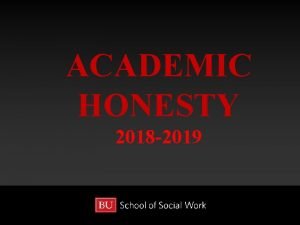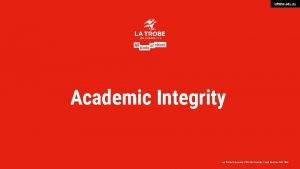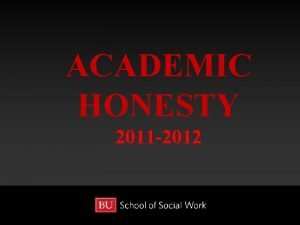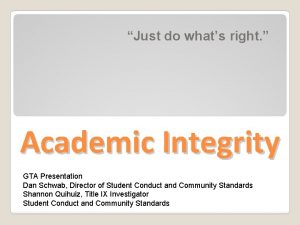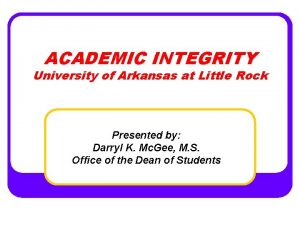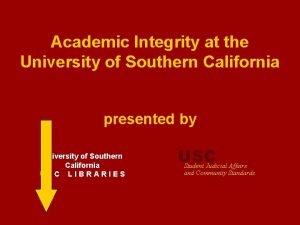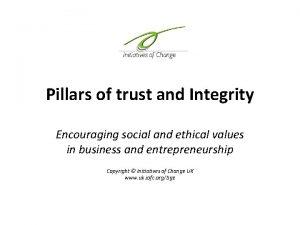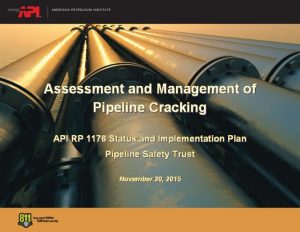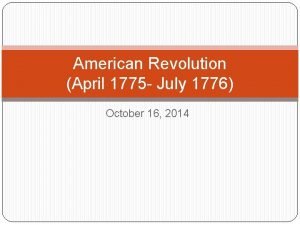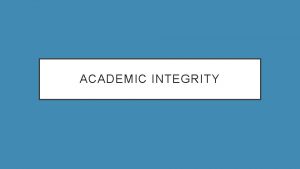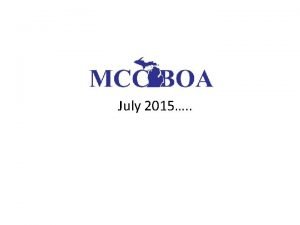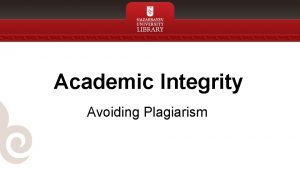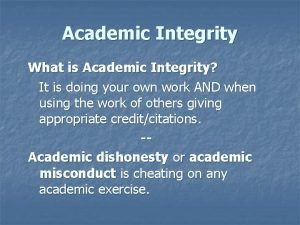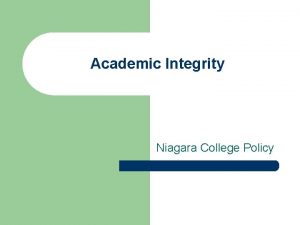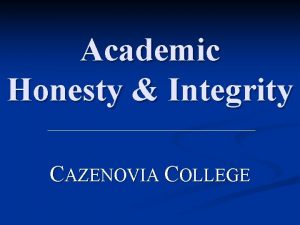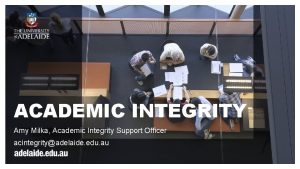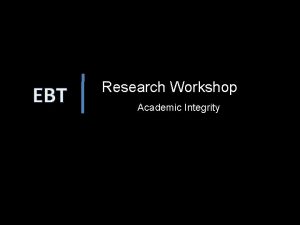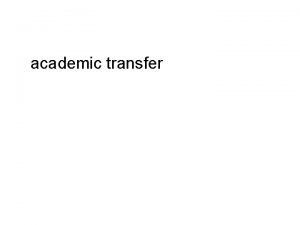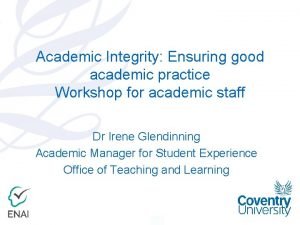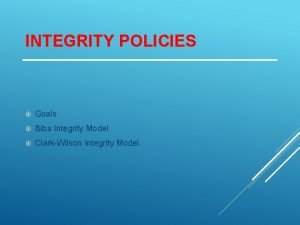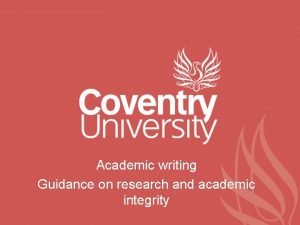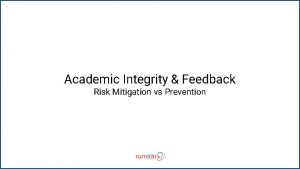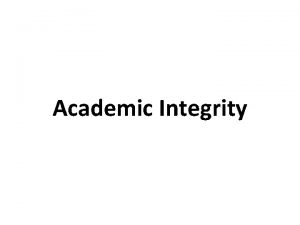ICPCACAN Academic Integrity Workshop July 2015 Integrity in





















- Slides: 21

ICPC/ACAN Academic Integrity Workshop July 2015 Integrity in Research P R O F M I K E F A B O R O D E , Secretary General, Committee Of Vice Chancellors mofaborode@cvcnigeria. org; mfaborode@yahoo. co. uk

Research is pivotal to economic growth and addressing societal challenges “Research is not a luxury which is the preserve of developed countries. . . Technology and innovation are key to achieving long-term economic and social development Science and innovation are recognised the world over as crucial to economic competitiveness. ” The Royal Society: Knowledge, Networks and Nations, 2011 The seminal work of Jamil (2009), included in the basic features of a world class university: Excellence in Research, International reputation, and the University’s contribution to society – research impact on development. It is given that such research must be credible & ethical.

RESEARCH OUTPUTS In relation to academic fraud and allied malpractices in research, we need to identify the outputs of research and of course its stages. The Outputs; The 5 Ps; Publication Prototype Patent Product: machines, devices, creative work Policy

RESEARCH STEPS/STAGES Proposal development/fund securing Actual research execution (Lab or Field work or both) Monitoring and evaluation Reports (narrative & financial) Post Research activities (Result dissemination, publications)

POSSIBLE RESEARCH MALPRACTICES ACTUAL RESEARCH STAGE: Research methodology and data integrity, Financial accountability and honesty PUBLICATIONS: plagiarism, splitting etc PROTOTYPE: Faking/Adulteration PATENT: Stealing PRODUCT: Faking/Adulteration/Piracy POLICY: Plagiarism

WHAT CAN WE DO? Preventive Measures: Awareness, advocacy and capacity building: - as in this workshop. Needs replication to trickle down in each institution. Entrench Research management principles – Adopt e-approach to RM. Use of Bibliometrics – Sci. Val, Google scholar, etc, as well as academic integrity software such as TURN-IT-IN, etc Institute structures for research conduct & ethics Disciplinary Measures: Using the university statutes and disciplinary procedures – requires collective responsibility to protect academic integrity The rest of the presentation slides will touch on the above starting with some case studies

CASE STUDIES Plagiarism: Staff publications – unscholarly publishing; Let’s discuss our experiences Staff promotions/employment – using citation analysis; RUST example of ‘rapid’ appraisal Post graduate students – Adamawa State Univ Undergraduate students University News – article CVC’s directives – ABUAD Declaration in World

SOME GOOD RESEARCH PROJECT STRATEGIES • PROJECT INCEPTION WORKSHOP: allows partnership to think together and plan project implementation with all team members understanding project goals, strategies, ethical issues and imperatives • PROJECT STAKEHOLDER ANALYSIS: must be in-depth and all embracing. Including the Press and communication experts in project team helps to implement an effective Communication Plan • TRANSPARENCY, probity and fairness in financial and management issues are very important. • INSTITUTIONAL/GROUP CAPACITY BUILDING: important for developing the next generation of researchers and leaders. Provision for graduate students and research assistants • PROGRESS REVIEW MEETINGS: always necessary to carry all team members along and share problems even on members academics; Institutionalises/enshrines internal M&E. • POLICY DIALOGUE: good for deepening research result uptake and overall project impact and sustainability.

LEADERSHIP IN RESEARCH • Research Environment: Research leadership starts at the institutional level with creating a conducive environment/platform for productive research engagement – policy; facilities, equipment, and consumables; funding; teams/groups/networks • Capacity building/mentoring: Mentoring of associates on proposal development, grants/fellowship sourcing, research ethics, management. • Research management: Project planning and execution; project finance ethics, project reports, outcomes dissemination; monitoring of institutional research progress through research outputs: the 5 Ps: publication, prototype, patent, product and policy.

SCHOLARLY PUBLISHING High impact publications; citation as a tool Indexed Journals: Journals rated according to citation impact. Prominent rating indexes include: Science Citation Index (SCI), Social Science Citation Index (SSCI), Scopus, etc • High Impact Publishing (HIJ): Identify the leading journals in your field and target them for publishing. • Examples of HIJ: Nature, Lancet, Scientific American, etc • Citation: Relates to how often a publication is referenced or used; An un-cited reference connotes irrelevance to knowledge. Citation has become a powerful tool for scientific analysis in research management, using Sci. Val. • Monitoring Citations: Use of search tools such as Google scholar, Embase, Science Direct, Pub. Med, etc. Use citation alerts to stay current and competitive.

RESEARCH MANAGEMENT WITH Sci. Val & Pure • Performance & Evaluation: • What are my interdisciplinary research strength • How are my researchers performing relative to their peers • Demonstration of Capabilities: • Identification of institutional research expertise and strategic importance, & how do we showcase our expertise to the world • Identify researchers in other disciplines within my institution & others with whom I can collaborate • Who are our major competitors • Research Enhancement: • Where are the right funding opportunities • Which are the most cited articles and authors within our research area • Dynamic Research Management: • Visualize research competencies • Navigate expertise networks • Survey award history and discover new funding opportunities 11

Research output & Growth Publications: Publications with at least one author affiliated to an institution in that country.

Research output & Growth Publications: Publications with at least one author affiliated to an institution in that country.

Field-weighted citation impact q = 1: the output performs just as expected for the global average q > 1 : the output is more cited than expected according to the global average; for example, 1. 48 means 48% more cited than expected q < 1: the output is cited less than expected according to the global average

Production - documents per subject area: 2007 - 2011 Source: Sci. Val Spotlight – Map of Cairo University, 2007 -2011

Impact - Normalized Citation Index (NCI) • • • Average number of citations per year, normalized per subject area against world’s average. Allows one to do comparisons between different fields NCI > 1: institution is having more impact than the world’s average in the field

February 2014 Webometrics Ranking for Africa Country Presence Rank* Impact Rank* Openness Rank* Cairo University Egypt 886 76 1325 391 University of Cape Town South Africa 760 556 655 3 504 Stellenbosch University South Africa 327 981 419 4 549 University of Pretoria South Africa 340 1154 196 5 632 University of Kwazulu Natal South Africa 1181 886 677 6 690 University of Witwatersrand South Africa 1600 1310 468 7 885 University of Western Cape South Africa 1941 606 2287 8 1060 Rhodes University South Africa 1039 1880 871 9 1167 University of Nairobi Kenya 1828 1898 774 Ranking World Rank University 1 299 2 Det.

Top-Level Research Governance Structure Vice Chancellor Grants and Proposals DVC (RDI) Registrar CSDO/ Director of Research Director, COR & ICT Training and Capacity Intellectual property/ Patents Research uptake Research Administrator (DR)

RESEARCH GOVERNANCE STRUCTURES v There should be a Central Office of Research, with an Intellectual Property Unit: to coordinate all research groups. It must be equipped with necessary research management tools, including bibliographic/citation management tools and linked to the University Library Repository; v. There should be a Research Policy for every institution: to ensure that the research function is well coordinated. v There is need to build institutional capacity in Research management, Uptake & Intellectual property Management, : to ensure conformity with the institution’s research policy v. Faculties and Departments Coordinators/Committees should have Research NOTE: Many universities already have an admin unit for research, but this needs to be strengthened with a DR and combined with ICT to be a substantive Directorate, with a Director. This new structures are necessary to reposition our universities for research and ICT governance excellence.

SUMMARY The fight against unethical practices in research needs to be taken very seriously in Nigerian HE institutions. It should be collectively seen as all-consuming and hence crucial for the maintenance of institutional integrity. Preventive Measures: Awareness, advocacy and capacity building: - as in this workshop Entrench Research management principles – Adopt eapproach to RM. Use of Bibliometrics – Sci. Val, Google scholar, etc, and academic integrity software e. g. TURN-IT-IN Institute structures governance for ethical and strategic research Disciplinary Measures: Using the university statutes and disciplinary procedures conscientiously in the interest of the system as against personal and parochial considerations.

Q&A
 Six fundamental values of academic integrity
Six fundamental values of academic integrity Tcnj academic integrity
Tcnj academic integrity Latrobe studiosity
Latrobe studiosity Five fundamental values of academic integrity
Five fundamental values of academic integrity Seneca mla
Seneca mla Whats academic integrity
Whats academic integrity University of arkansas academic integrity
University of arkansas academic integrity Usc academic dishonesty
Usc academic dishonesty 5 pillars of academic integrity
5 pillars of academic integrity Pipeline crack management
Pipeline crack management June too soon july stand by
June too soon july stand by Monday 13th july
Monday 13th july Poppies in july aoifes notes
Poppies in july aoifes notes July 16 1776
July 16 1776 July 1-4 1863
July 1-4 1863 The hot july sun beat relentlessly down
The hot july sun beat relentlessly down Ctdssmap payment schedule july 2021
Ctdssmap payment schedule july 2021 July 30 2009 nasa
July 30 2009 nasa Malaga in july
Malaga in july July 2 1937 amelia earhart
July 2 1937 amelia earhart On july 18 2001 a train carrying hazardous chemicals
On july 18 2001 a train carrying hazardous chemicals Miss cuba receives an invitation
Miss cuba receives an invitation
